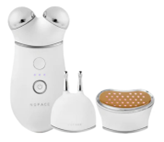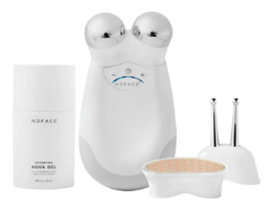Do They Really Work? NuFACE Lawsuit Says Red-Light Therapy Devices Do Not Provide the Advertised Skincare Benefits
A proposed class action lawsuit alleges the NuFACE Trinity+ and Trinity Classic facial toning devices and wrinkle reducer attachments do not work as advertised given that the red-light therapy and microcurrent technology products are incapable of providing their touted skincare benefits.
Want to stay in the loop on class actions that matter to you? Sign up for ClassAction.org’s free weekly newsletter here.
The 32-page false advertising lawsuit against Carol Cole Company, Inc. says that although the NuFACE Trinity+ and Trinity Classic and their red-light therapy attachments are marketed as being capable of reducing wrinkles in “just 3 minutes” and “… lab-tested and FDA-Cleared” to boost collagen production, fix discoloration and reduce inflammation, the products do not produce enough radiant exposure to provide these benefits.
Further, the case says the at-home NuFACE products are neither “clinically proven” nor capable of providing the advertised benefits of the defendant’s microcurrent technology, which the company claims can enhance collagen and elastin production, improve circulation, and tighten and tone the skin.
According to the class action suit, NuFACE has misled and deceived consumers because they would not have bought the Trinity+ and/or Trinity Classic devices and attachments—or would have paid far less for them—had they known they were incapable of providing the advertised skin rejuvenation benefits.
Effectiveness of red light therapy
The NuFACE Trinity devices and their attachments utilize red-light therapy and microcurrent technology to purportedly improve a user’s skin, the filing explains. Per the suit, red-light therapy involves repeatedly exposing the skin to low levels of LED light for a certain amount of time and, based on the specific usage of a device, can help treat skin conditions ranging from eczema, acne and psoriasis to rosacea, sun damage and wrinkles.

Although red-light therapy is used commonly by dermatologists and estheticians with commercial products, at-home devices are “typically weaker than professional equipment” and do not produce the same anti-aging or acne-combating results, the lawsuit notes.
Indeed, the efficacy of LED light treatment devices, such as masks and portable products, in general remains “questionable,” with researchers split as to how much the items can actually improve the skin, the complaint relays.
The case summarizes that the at-home NuFACE products are unable to produce the advertised skincare benefits because they do not produce a necessary level of radiant exposure output.
Independent testing shows that while the Trinity Classic produces an adequate wavelength and power density to provide “some” therapeutic skincare benefits, the radiant exposure is insufficient, specifically 28 to 504 times lower than the effective doses cited in scientific literature, the lawsuit says.
Per the case, the Trinity+ device, which is substantially similar to the Trinity Classic, “also suffers from this defect.”
Purported microcurrent benefits also miss the mark, NuFACE class action says

Microcurrent technology is a non-invasive therapy whereby low-level electrical currents are used to stimulate the skin and facial muscles, the case explains. While professional-grade microcurrent technology, whose higher settings allow for deeper penetration into the skin, is used by spas, dermatology clinics and physical therapy centers, the strength of at-home devices is often much lower, meaning the skincare results, if any, are “slower and less pronounced,” the suit says.
The class action suit, citing an expert who reviewed Carol Cole Company’s scientific literature and his own clinical use of the technology, claims the NuFACE Trinity+ and Trinity Classic devices “cannot possibly deliver the advertised microcurrent benefits.”
“Users may need to apply the devices consistently over a longer period to see any noticeable improvements [from microcurrent technology], and the effects may not be as long-lasting,” the complaint relays. “More significantly, scientific research on Devices like those sold by Defendant indicate that users may see only modest improvements in skin texture and firmness, but these changes are often mild and temporary.”
Lastly, the case contends that the Trinity+ and Trinity Classic devices are not clinically proven as advertised as the defendant provides only consumer-use studies on its websites.
“While such studies may be appropriate to cite to for marketing claims, they are not randomized double-blind and placebo controlled scientific studies that can support a ‘clinically proven’ claim,” the lawsuit argues.
Who can join the NuFACE lawsuit?
The NuFACE class action lawsuit looks to cover all individuals in the United States who, within the applicable statute of limitation period, bought a Trinity+ or Trinity Classic device and/or the accompanying red-light attachments.
How do I sign up for the NuFACE lawsuit?
There’s nothing you need to do to join or sign up for a class action lawsuit when it is initially filed. The time to act is usually in the event of a class action settlement, when class members covered by the deal may need to fill out and file a claim form online or by mail.
ClassAction.org will update this page as the NuFACE lawsuit develops, so check back often.
Check out ClassAction.org’s lawsuit list for the latest top class action lawsuits.
Video Game Addiction Lawsuits
If your child suffers from video game addiction — including Fortnite addiction or Roblox addiction — you may be able to take legal action. Gamers 18 to 22 may also qualify.
Learn more:Video Game Addiction Lawsuit
Depo-Provera Lawsuits
Anyone who received Depo-Provera or Depo-Provera SubQ injections and has been diagnosed with meningioma, a type of brain tumor, may be able to take legal action.
Read more: Depo-Provera Lawsuit
How Do I Join a Class Action Lawsuit?
Did you know there's usually nothing you need to do to join, sign up for, or add your name to new class action lawsuits when they're initially filed?
Read more here: How Do I Join a Class Action Lawsuit?
Stay Current
Sign Up For
Our Newsletter
New cases and investigations, settlement deadlines, and news straight to your inbox.
Before commenting, please review our comment policy.